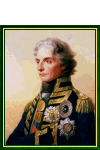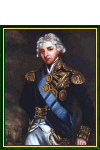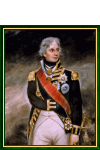1st Viscount Nelson, 1st Duke of Bronté
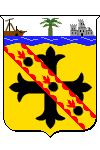
Horatio Nelson was born on September 29, 1758 in the village of Burham Thorpe, Norfolk, in the east of England. His father was the local vicar while his mother was the great-niece of Lord Robert Walpole who was Prime Minister for nearly 20 years during the reigns of George I and George II.
His mother died when he was only three years old, but at the age of eleven Horatio joined the Royal Navy as a sailor and very soon began training to be an officer.
He sailed across the Atlantic on two occasions and then set out for the Indies. It was there that he experienced a baptism by fire in the form of the First Anglo-Maratha War. While in the Indies, he also caught malaria for the first time.
He was promoted to lieutenant in April 1777 and was serving in the Caribbean fleet at the outbreak of the American War of Independence during which he distinguished himself on several occasions. However, the return of malarial symptoms forced him to return to England in 1780.
Between 1781 and 1783, he was the captain of the frigate HMS Albemarle in Quebec and then in the Caribbean under Admiral Samuel Hood. With the return of peace in 1783, he spent several months in Saint-Omer where he even started learning French.
He married Frances "Fanny" Nisbet, a young widow with a five year old son, in 1787 on the island of Nevis. He was demobilized the next year and only returned to the navy in 1792 just before England joined the First Coalition.
He served in the Mediterranean accompanying the British ambassador William Hamilton. During this time he met Hamilton's young wife Emma for the first time. He fought at Toulon, Cagliari in Sardinia and then in Corsica where he participated in the sieges of Bastia and Calvi where he lost the use of his right eye. He also fought outside of Genoa.
At the beginning of 1796, John Jervis, the new commander-in-chef of the Mediterranean fleet, promoted Nelson to commodore and tasked him with organizing the blockade of the French coast. However, by the end of the year the French advances in Italy compelled the Royal Navy to withdraw from the Mediterranean. During the withdrawal, Nelson only just managed to escape capture by the Spanish as he passed Gibraltar. He played a prominent role in the victory at the Cape Saint Vincent on February 14, 1797 over the Spanish and was made a Knight of the Order of the Bath as a result. The same year he fought at Cadiz and then at Santa Cruz de Tenerife where he suffered a resounding defeat
He returned to England where he was unexpectedly welcomed as the hero of the Battle of Cape Saint Vincent rather than as the loser at Tenerife. He bought a cottage near Ipswich but only stayed there a few months.
Beginning in March 1798, Nelson was given the command of a fleet tasked with hunting down the French forces sailing to Egypt. As he was unaware of the enemy's final destination, he was forced to pursue them along the Italian coast and then to Malta and Alexandria. As he began to think he would have to return empty-handed, he learned by chance that the French fleet under the command of Vice-Admiral François Paul de Brueys d'Aigalliers was anchored in the Aboukir Bay. Despite being out-gunned, he was able to obliterate his enemy through a strategy that displayed his tactical genius. Known as the Battle of the Nile, this victory established the supremacy of the Royal Navy in the seas for more than a century.
Nelson returned to Naples
At the end of 1798, he organized the British retreat following the capture of Naples
Called back to England, he returned by land in the company of the Hamiltons. In Vienna, Joseph Haydn dedicated a newly-composed mass in his honour that still bears his name.
In 1801, Horatio Nelson became a father when Emma Hamilton gave birth in January to a daughter named Horatia. He distinguished himself later that year at the Battle of Copenhagen in April after which he was finally made a viscount and named commander-in-chief of the Baltic Sea. In this role, he was tasked with defending the Channel against Bonaparte's planned invasion of Britain. The peace treaty signed at Amiens on October 22, 1801 allowed him to return to England and to the Hamiltons.
The Peace of Amiens ended in May 1803 and with the formation of the Third Coalition, Nelson was promoted to vice-admiral and took command of Mediterranean fleet aboard HMS Victory.
On October 21, 1805 near Cadiz, Nelson engaged an enemy fleet of 33 French and Spanish ships under the command of Admiral Pierre Charles Silvestre de Villeneuve with only 27 of his own. This was Trafalgar.
Three hours later Horatio Nelson was dead
He was given a full state funeral in London at Saint Paul's Cathedral
"Horatio Nelson" by Lemuel Francis Abbott (Leicestershire 1760 / 1761 - London 1802).
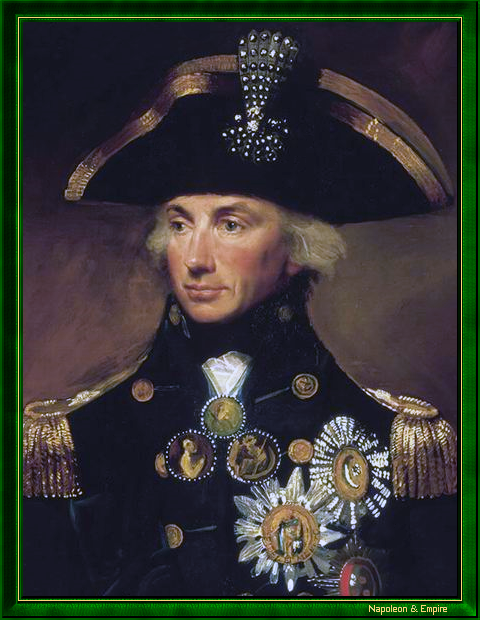
As one of the greatest British war heroes, many monuments bear his name. The most notable is Nelson's Column in Trafalgar Square in London that is tall enough, according to local myth, that his statue
Despite being one of the most celebrated sailors of all time, Nelson suffered from sea-sickness his entire life.
